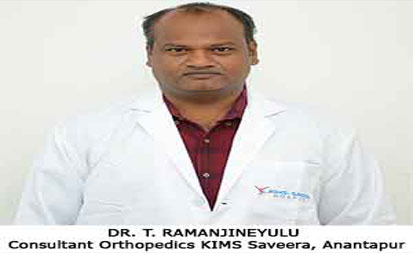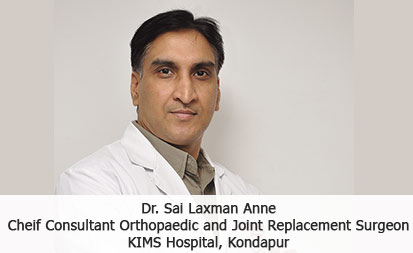National Bone & Joint Day
We are celebrating Bone and Joint day on 4th August. Our slogan is “Stronger bones Stronger India – because we believe healthier the bones, healthier the society and stronger the nation.” Bones, muscles and joints hold

We are celebrating Bone and Joint day on 4th August. Our slogan is “Stronger bones Stronger India – because we believe healthier the bones, healthier the society and stronger the nation.”
Bones, muscles and joints hold our body together and support freedom of movement. They are part of the musculoskeletal system (also known as the locomotor system). Your bones are pieces of the skeletal structure that give the body a certain shape. Bones are made up mostly of collagen and calcium phosphate. Joints are the connectors that join bones, teeth, and cartilage of the body to one another.

BONES AND JOINTS HEALTHY
Healthy bones and joints are essential to a healthy body not only when you are older, but as you grow. Neglecting your bones and joints can quickly lead to a number of health issues that will make life harder and less enjoyable.
Let’s start with bones!
From the time you are born, your body begins to develop your bones. As you continue to grow, the cartilage in your bone also grows and it is slowly replaced by bone with the help of calcium. It is important to improve the bone health of female child as they are going to be future mothers. During the teenage, 40−60% peak bone mass is built.
There is then a period of consolidation but, from the age of about 40 years, bone loss exceeds Excessive loss of bone tissue leads to osteoporosis, a condition that is characterized by bone fragility and increased risk of bone fracture. Osteoporosis may lead to mobility problems
It is important to optimize bone mass during growth and to maintain the skeleton during adult life in order to reduce the risk of osteoporosis developing in later life
Another bone abnormality, rickets in children. Rickets is a condition that results from a delay in deposition of bone mineral (especially calcium and phosphate) in growing bones, usually as a result of poor vitamin D status, and is characterized by skeletal deformities, especially bowed legs. In adults, the equivalent disease is osteomalacia and is again characterized by poor mineralization of the bone matrix (in contrast, osteoporosis is characterized by low bone mass in which the matrix itself becomes more fragile)
Factors affecting bone strength
Bone strength in later life is affected to some extent by genetic factors but there are a number of other hormonal and lifestyle factors.
Oestrogen plays an important role in women in protecting bone and so irregular or loss of menstrual periods can be detrimental to bone. After the menopause, oestrogen is no longer produced and this is the reason for the increase in bone loss in women compared to men of the same age.
Diet and nutrient status are important factors in formation of healthy bones, in particular calcium, vitamin D and vitamin K.
Calcium
The mineral calcium is obtained from the diet and deposited in bones and teeth. Adults typically have about 1kg of calcium in their bodies and 99% of this is present in bone. . The richest sources of calcium in the diet are milk and dairy products, with milk, yogurt and cheese providing about half of the calcium consumed in the diet. Green vegetables, such as spring greens and broccoli, contain calcium. Fish that is eaten with the bones, are also an important source. In some areas of the country, hard water provides a significant amount of calcium.
Vitamin D
Sunlight Vitamin D assists in the absorption of calcium from food. Some vitamin D is acquired from the diet but for most people the major source is through synthesis in skin that is exposed to sunlight. Fish liver oils have very high levels . Egg yolk, liver and butter contain smaller amounts of vitamin D.
Vitamin K
There are at least three vitamin K-dependent proteins present in bone. People with osteoporosis have been shown to have low blood levels of vitamin K, and low vitamin K intake and impaired vitamin K status are associated with lower bone mass and higher risk of hip fracture in older men and women. The main sources of vitamin K are green leafy vegetables, meat and dairy products.
Oligosaccharides
Recent evidence from human studies supports animal evidence that daily consumption of inulin-type oligosaccharides can increase calcium absorption. This may be of particular importance for people with a low calcium intake.
Physical activity, especially weight bearing activity, is of critical importance in building and maintaining strong bones. Bones respond to the weight they carry which means that low body weight is a risk fracture for bone fragility and fracture in older people, in particular.
Now, why is joint health so important?
You’ve probably seen commercials of seniors who look downtrodden after their grandchild asks them to play with them outside. They always seem to complain about arthritis and joint pain. Arthritis is an inflammation of one or more joints that can lead to stiffness and make it painful to walk or move. Many times, arthritis and joint pain affect those who are ages 40 and older, but some suffer from it at a younger age.
A FEW TIPS TO KEEPING BONES AND JOINTS HEALTHY
Exercise and maintain a healthy body weight so you don’t put added pressure on your bones and joints.. The physical exercises (Compulsory participation in sport), adequate milk intake, calcium, other minerals and vitamins supplements, fruits and vegetables intake promote bone formation Soak up the sun! Your body is in need of the vitamin D to absorb the calcium you need for healthy bone Soda and cola drinks containing considerable amount of phosphorus an acid forming mineral interfere with the skeleton’s ability to absorb calcium must be discouraged.




